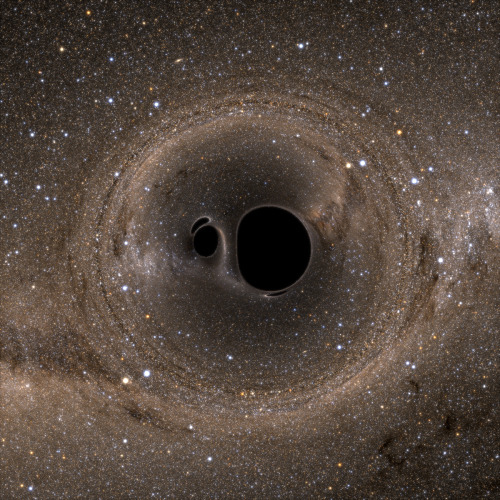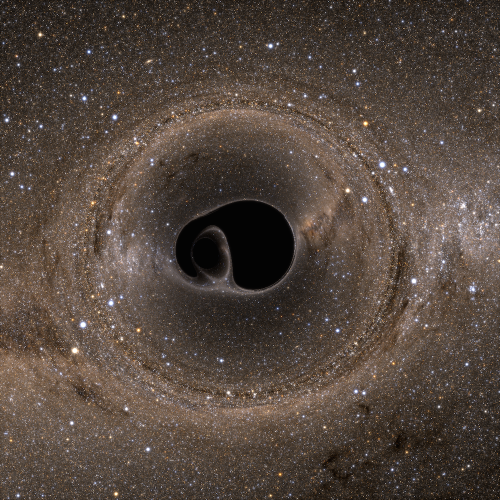Adam Priester On Society6










Adam Priester on Society6
Browse more curated art or illustration
So Super Awesome is also on Facebook, Twitter and Pinterest
More Posts from Paratus-simulator and Others


A Black Hole is an extraordinarily massive, improbably dense knot of spacetime that makes a living swallowing or slinging away any morsel of energy that strays too close to its dark, twisted core. Anyone fortunate (or unfortunate) enough to directly observe one of these beasts in the wild would immediately notice the way its colossal gravitational field warps all of the light from the stars and galaxies behind it, a phenomenon known as gravitational lensing.
Thanks to the power of supercomputers, a curious observer no longer has to venture into outer space to see such a sight. A team of astronomers has released their first simulated images of the lensing effects of not just one, but two black holes, trapped in orbit by each other’s gravity and ultimately doomed to merge as one.
http://www.universetoday.com/116500/new-simulation-offers-stunning-images-of-black-hole-merger/?








NASA originally commissioned these posters for an exhibit at the Kennedy Space Center Visitor’s Complex in 2009. As part of their Journey to Mars, these versions are now available to everyone online.
Credit: NASA/KSC

Cone Nebula
A large, faint emission nebula and bright galactic association of stars known as The Christmas Tree Cluster form object NGC 2264, which itself contains a unique feature known as the Cone Nebula. The Cone Nebula’s shape comes from a dark absorption nebula consisting of cold molecular hydrogen and dust in front of a faint emission nebula containing hydrogen ionized by nearby star S Monocerotos, the brightest star of NGC 2264. The faint nebula is approximately seven light-years long and is 2,700 light-years away from Earth.
Credit: David M. Jurasevich
(In the Paratus universe, the Soviets landed on the Moon first.)










Newly Released High Resolution Film Scans from Apollo Missions
8,434 photos from the Apollo missions were just uploaded to flickr by NASA!
-
 angryblondewithajetblackheart liked this · 1 month ago
angryblondewithajetblackheart liked this · 1 month ago -
 pistanthrophobica liked this · 6 months ago
pistanthrophobica liked this · 6 months ago -
 whirlberry reblogged this · 7 months ago
whirlberry reblogged this · 7 months ago -
 whirlberry liked this · 7 months ago
whirlberry liked this · 7 months ago -
 quinnvolt liked this · 8 months ago
quinnvolt liked this · 8 months ago -
 angelic-cheetah-dragon liked this · 8 months ago
angelic-cheetah-dragon liked this · 8 months ago -
 ravensrebel liked this · 8 months ago
ravensrebel liked this · 8 months ago -
 massivebittrip liked this · 8 months ago
massivebittrip liked this · 8 months ago -
 moonlightandmarble reblogged this · 8 months ago
moonlightandmarble reblogged this · 8 months ago -
 moonlightandmarble liked this · 8 months ago
moonlightandmarble liked this · 8 months ago -
 thescalieredpumpkin liked this · 1 year ago
thescalieredpumpkin liked this · 1 year ago -
 probably-b liked this · 1 year ago
probably-b liked this · 1 year ago -
 notsouniqename liked this · 1 year ago
notsouniqename liked this · 1 year ago -
 lammergeier-spitfire reblogged this · 1 year ago
lammergeier-spitfire reblogged this · 1 year ago -
 abnermz-5 liked this · 1 year ago
abnermz-5 liked this · 1 year ago -
 endless-traveler reblogged this · 1 year ago
endless-traveler reblogged this · 1 year ago -
 endless-traveler liked this · 1 year ago
endless-traveler liked this · 1 year ago -
 zedtae reblogged this · 1 year ago
zedtae reblogged this · 1 year ago -
 gatsbylafitte reblogged this · 1 year ago
gatsbylafitte reblogged this · 1 year ago -
 lavgoose reblogged this · 1 year ago
lavgoose reblogged this · 1 year ago -
 lavgoose liked this · 1 year ago
lavgoose liked this · 1 year ago -
 flickering-pie reblogged this · 1 year ago
flickering-pie reblogged this · 1 year ago -
 flickering-pie liked this · 1 year ago
flickering-pie liked this · 1 year ago -
 superectojazzmage reblogged this · 1 year ago
superectojazzmage reblogged this · 1 year ago -
 flowersandmemes1298 liked this · 1 year ago
flowersandmemes1298 liked this · 1 year ago -
 seekeroftheextraordinary reblogged this · 1 year ago
seekeroftheextraordinary reblogged this · 1 year ago -
 seekeroftheextraordinary liked this · 1 year ago
seekeroftheextraordinary liked this · 1 year ago -
 supersoftly reblogged this · 1 year ago
supersoftly reblogged this · 1 year ago -
 dnelld liked this · 1 year ago
dnelld liked this · 1 year ago -
 camusblack liked this · 1 year ago
camusblack liked this · 1 year ago -
 williamskyw liked this · 1 year ago
williamskyw liked this · 1 year ago -
 ettorestyle liked this · 1 year ago
ettorestyle liked this · 1 year ago -
 corse2b liked this · 1 year ago
corse2b liked this · 1 year ago -
 gameover77world liked this · 1 year ago
gameover77world liked this · 1 year ago -
 wachsurfer2018 reblogged this · 1 year ago
wachsurfer2018 reblogged this · 1 year ago -
 wachsurfer2018 liked this · 1 year ago
wachsurfer2018 liked this · 1 year ago -
 sunlitleaves reblogged this · 1 year ago
sunlitleaves reblogged this · 1 year ago -
 shewaslight reblogged this · 1 year ago
shewaslight reblogged this · 1 year ago -
 laurengoesforaspin reblogged this · 1 year ago
laurengoesforaspin reblogged this · 1 year ago -
 motleyreviewsbackup liked this · 1 year ago
motleyreviewsbackup liked this · 1 year ago -
 laurengoesforaspin liked this · 1 year ago
laurengoesforaspin liked this · 1 year ago -
 bad-jew-jew reblogged this · 1 year ago
bad-jew-jew reblogged this · 1 year ago -
 religiousdonut reblogged this · 1 year ago
religiousdonut reblogged this · 1 year ago -
 hexuhgone reblogged this · 1 year ago
hexuhgone reblogged this · 1 year ago -
 infernally-b liked this · 1 year ago
infernally-b liked this · 1 year ago






